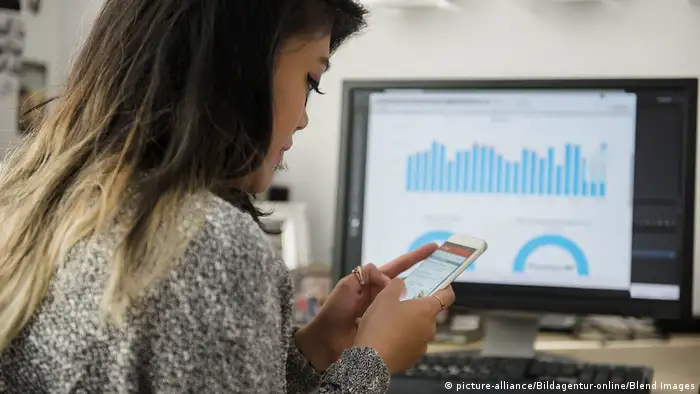In focus
Data journalism in times of coronavirus
The head of DW's data-driven unit Gianna-Carina Gruen shares her thoughts on data journalism in the COVID-19 pandemic. You can hear her speak more in-depth on the topic in the webinar linked in this article.
Gianna-Carina Gruen is a data journalist and editor at DW where she runs DW's data-driven journalism unit. She recently presented at a webinar on data journalism and investigative journalism in the time of the Covid-19 pandemic, which was part of a webinar series for "Dataship — The Data Journalism Fellowship."
DW Akademie: How do you see data journalism's role in this pandemic?
Gianna-Carina Gruen: To me, the pandemic highlighted the role of data-driven journalism to provide readers in an emotional situation with fact-based information, to give context and generate insights by following the "show, don't tell" principle — ultimately, hopefully informing people’s opinion, decisions and actions.
In some countries, you can't trust the numbers published by official sources. If this is the case, what can you do?
That's a difficult situation to be in. Even if the official source is a trustworthy one, reported case numbers naturally come with some sort of inaccuracy as they don’t account for those cases that, for example, stay asymptomatic and never go to a hospital to be tested and this way never appear in any statistic.
One way to go about untrustworthy numbers could be to make the untrustworthiness the story itself and raise awareness for this issue and its scope and impact — since knowledge can literally mean the difference between life and death of people in this situation.
You could also try to find experts who might — based on their experience — be able to assess how much higher or lower the numbers likely are.
Another resort could be to go hyperlocal, instead of attempting to get numbers for an entire country, maybe it is possible for you to establish the numbers for single hospitals and generate a local story out of that. When following such an approach it's important (as for any data-driven journalism story) to find experts that bullet-proof your methodology or can raise possible biases or pitfalls.
What have data journalists achieved during the coronavirus pandemic? What are some of the best examples of data journalism?
Data journalists and their work gained a lot of visibility due to the pandemic — both with readers as well as internally with fellow journalists. I think more people now see the benefits and opportunities that lie in data-driven stories.
To me, it's difficult to single out "best" examples, since we are looking at a variety of data journalism: on the one hand, we have seen more descriptive approaches like the British Financial Times newspaper used for one of their "Coronavirus tracked" pieces, and then there are data-driven analytical approaches, like the Washington Post newspaper's piece on health disparities in communities of color. I think you can’t really compare them one on one, as they fulfil different purposes.
Read more: Media development amid the coronavirus crisis
What are some of the mistakes journalists have made while reporting on the pandemic?
Something I've seen quite often, especially in the early days of the pandemic, is that numbers are communicated down to the last digit. But given how numbers are produced, this is a level of accuracy the numbers inherently cannot have — so I believe they shouldn't be communicated that way but rather rounded. Another reason is that everything is moving so fast that precise numbers like "13,456 cases" are outdated faster than if you say "more than 13,000 reported cases," for example.
Another aspect I've noted is that in some pieces it might be more useful to not look at absolute case numbers, but instead put them in relation to population figures: because of course a country with more people can also potentially see more cases.
Beyond that, there's also this great essay by data scientist and journalist William R. Chase that I recommend: "Why I'm not making Covid19-visualizations and why you shouldn't either." If you do want to make or have to make Covid-19 visualizations nonetheless, the "Ethical Design Recommendations for Covid-19 Visualizations" by Katherine Hepworth, Associate Professor of Visual Journalism, Reynolds School of Journalism, University of Nevada, are a great resource.
What should journalists be aware of when reporting on coronavirus?
I believe it's important to acknowledge and incorporate in our reporting that this pandemic is an evolving situation: most of what we report on can change, even quickly. So, it's important to be very clear of the preliminary and temporary nature of the communicated information: for example, when reporting numbers or explanations it's important to date this information.
At the same time, there are many things we don't know yet about the virus or the pandemic — so even what we think we know today, might change in a week or two from now. And there might be aspects we don’t know yet to be important — in this context, I highly recommend the "unknown knowns" matrix that is used to assess risks and is also a great concept in a data journalism context.
Gianna-Carina Gruen is a data journalist and editor with DW (Deutsche Welle), Germany's international media company. She currently runs DW's data-driven unit, which she founded in 2017. She holds a Masters degree in Molecular Biomedicine and graduated from Columbia University’s Lede Program, an intensive course in coding and analysis. She combines several years of journalistic experience as a multimedia online editor and science writer with both programming and design skills. When she's not producing or editing data-driven stories and visuals, she spreads enthusiasm for data journalism as a data-driven journalism trainer.
Watch the webinar on data journalism and investigative journalism in times of corona below or on YouTube.
- Date 10.07.2020
- Author Louisa Wright
- Feedback: Send us your feedback.
- Print Print this page
- Permalink https://p.dw.com/p/3f47v
- Date 10.07.2020
- Author Louisa Wright
- Send us your feedback.
- Print Print this page
- Permalink https://p.dw.com/p/3f47v


